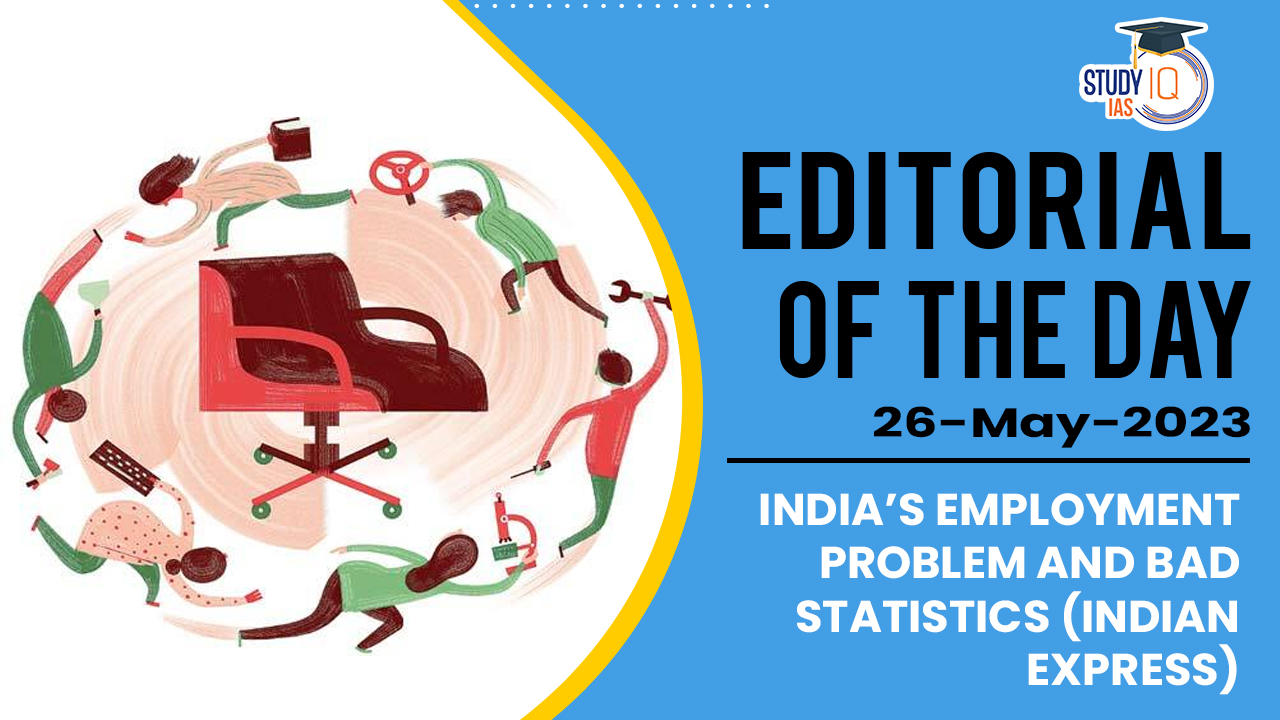Table of Contents
Context: The article is discussing the pressure on India to revise its definition of unemployment to align with international standards. It highlights the decline in the reputation of India’s statistical system, citing instances such as the disavowal (rejection) of poverty data and a lack of investment in analytical capacity. The article mentions that India’s definition of employment does not meet international standards and that international bodies like the International Labour Organisation (ILO) have recommended India to adopt the standards set by the 19th International Conference of Labour Statisticians (ICLS-19) held in 2013. The article simultaneously raises the question and analyses whether these recommendations are appropriate for a transitional economy like India, where a significant portion of the population is engaged in agriculture and casual wage work.
India’s Employment Problem and Bad Statistics Background
What is Unemployment?
- Unemployment is referred to as the condition when individuals belonging to the age group of the working population are searching for a job and are not able to avail.
- Unemployment is often used as a measure of the health of the economy. The most frequent measure of unemployment is the unemployment rate, which is the number of unemployed people divided by the number of people in the labour force.
- National Sample Survey Organization (NSSO) defines employment and unemployment on the following activity statuses of an individual:
- Working (engaged in an economic activity) i.e., ‘Employed’.
- Seeking or available for work i.e., ‘Unemployed’.
- Neither seeking nor available for work.
- The first two constitute the labour force and the unemployment rate is the percentage of the labour force that is without work.
- Unemployment rate = (Unemployed Workers / Total labour force) × 100.
Measurement of Unemployment in India
- National Sample Survey Office (NSSO), an organisation under the Ministry of Statistics and Programme Implementation (MoSPI) measure unemployment in India on the following approaches:
- Usual Status Approach: This approach estimates only those persons as unemployed who had no gainful work for a major time during the 365 days preceding the date of survey.
- Weekly Status Approach: This approach records only those persons as unemployed who did not have gainful work even for an hour on any day of the week preceding the date of the survey.
- Daily Status Approach: Under this approach, the unemployment status of a person is measured for each day in a reference week. A person who has no gainful work even for 1 hour in a day is described as unemployed for that day.
Decoding the Editorial
The article poses a question regarding the appropriateness of the recommendations made by ICLS-19 for a transitional economy like India. The author suggests that in order to evaluate the appropriateness of these recommendations, it is necessary to understand the two major recommendations put forth by ICLS-19 and then examine them in the Indian context.
Recommendations by ICLS-19:
- The first recommendation is that employment data should be based on short-term measures, typically a 7-day measure, which captures employment during the preceding week.
- This means that instead of relying on long-term measures, such as monthly or annual data, the focus should be on capturing more immediate and recent employment information.
- The second recommendation is that all types of work, including unpaid work, should be taken into account, but a person should be considered employed only if they are engaged in producing goods or services for pay or profit.
- This distinction between work and employment implies that while unpaid work is recognized, individuals are considered employed only if their work involves producing goods or services for which they receive monetary compensation.
- This distinction can have critical implications for measuring progress towards the Sustainable Development Goals (SDGs), which are global goals aimed at addressing social, economic, and environmental challenges.
Recommendations on “Conditions of Work”:
- The global recession in 2008 had a significant impact on high-income countries, and its effects were also felt in countries and sectors closely tied to the global economy.
- In response to this, international labour statisticians recommended that countries collect employment statistics that would assess and monitor the “conditions of work” and develop measurements that could be useful for labor-management negotiations.
- To achieve this, it was deemed important to have accurate estimates of underemployment.
- Underemployment refers to situations where individuals are working less than their desired hours or are engaged in jobs that do not fully utilize their skills and qualifications.
- To obtain reliable data on underemployment, the statisticians advocated for using a short measurement period to minimize biases arising from recalling past employment situations.
- Furthermore, the focus of measurement was suggested to be on activities that are performed for pay or profit. This means that only work that involves producing goods or services in exchange for monetary compensation should be considered as employment.
- The exclusion of work done for personal use was likely implemented because there was a concern that some countries might inflate their employment rates by counting activities that are done out of necessity or in distress, rather than providing proper paying jobs.
Applicability of “Employment” Definition:
There are concerns raised about the applicability of the recommended definition of employment, particularly for countries with a large informal sector and subsistence farming, such as India.
- Adopting the proposed definition would result in a significant reduction in the proportion of the population considered employed in rural areas.
- The calculations based on the India Human Development Survey (IHDS) indicate that nearly half of the households engaged in cultivation do not sell their produce in the same year.
- This is often due to small farm sizes that only produce enough for family consumption.
- However, many small and marginal farmers also work as wage laborers or salaried workers.
- The impact of the proposed definition, which focuses on work for pay or profit, is relatively minor for these individuals. Over 90 percent of those involved in various income-generating activities related to farming, wage labor, animal care, or business over the course of a year would be classified as employed based on the ICLS-19 definition.
However, the author highlights significant gender differences.
- If the limitation of work for pay or profit is applied, approximately 95 percent of men currently considered employed would continue to be classified as such, whereas only 85 percent of women would meet the definition.
- This would result in further lowering the already low estimates of women’s employment.
The recommendation to rely on a one-week reference period for measuring employment is also questioned.
- While it may reduce measurement errors, it may not capture the full extent of individuals’ economic activities.
- In rural India, many people engage in multiple activities, combining farm work with construction, work under the Mahatma Gandhi National Rural Employment Guarantee Scheme (MGNREGS), or other work in nearby towns.
- During the sowing or harvesting seasons, they dedicate all their time to farming.
- If surveys are conducted during these periods, individuals would be classified primarily as farmers, and estimates suggest that 45 percent may be considered as producing solely for home consumption. As a result, they would not be counted as employed, even if they engage in income-generating activities during other parts of the year.
The author suggests that:
- Changing the definitions of employment and adopting the recommendations of ICLS-19 could potentially underestimate the strength of the Indian economy and not serve any policy purpose.
- He highlights that despite the potential for artificially reducing employment figures, international bodies continue to advocate for the adoption of these recommendations.
- The lack of dissenting voices outside the Ministry of Statistics and Programme Implementation (MOSPI) is seen as a tragedy, indicating the loss of reputation suffered by India’s statistical system.
Therefore, there is a need for India’s statistical system to regain confidence, engage assertively with international organizations, adopt global best practices when appropriate, and resist pressure to do so when it does not align with policy needs.
Beyond the Editorial
Steps Taken by the Government to tackle Unemployment:
The government has implemented several steps to tackle unemployment.
- Integrated Rural Development Programme (IRDP): Launched in 1980, this program aimed to create full employment opportunities in rural areas by providing income-generating assets and skill development training to rural households.
- Training of Rural Youth for Self-Employment (TRYSEM): Started in 1979, TRYSEM focused on providing skills training to unemployed rural youth aged between 18 and 35 years. Priority was given to SC/ST youth and women to promote inclusive growth.
- RSETI/RUDSETI: The Rural Development And Self Employment Training Institute (RUDSETI) was set up in 1982 near Dharmasthala in Karnataka. This initiative, in collaboration with educational trusts and banks, aimed to mitigate youth unemployment by providing training and support for self-employment. Rural Self Employment Training Institutes (RSETIs) are now managed by banks with government cooperation.
- Jawahar Rozgar Yojana (JRY): Introduced in 1989 by merging the National Rural Employment Programme (NREP) and the Rural Landless Employment Guarantee Programme (RLEGP), JRY aimed to provide wage employment opportunities in rural areas. It operated on an 80:20 cost-sharing basis between the central government and the states.
- Mahatma Gandhi National Rural Employment Guarantee Act (MNREGA): Launched in 2005, MNREGA guarantees a minimum of 100 days of paid work per year to adult members of rural households who opt for unskilled labor-intensive work. It provides social security and a right to work for people in rural areas.
- Pradhan Mantri Kaushal Vikas Yojana (PMKVY): Started in 2015, PMKVY focuses on providing industry-relevant skill training to Indian youths, enabling them to secure better livelihoods. It offers skill development programs across various sectors and provides certification upon successful completion.
- Start Up India Scheme: Launched in 2016, this initiative aims to promote and nurture entrepreneurship across the country. It provides support and incentives for startups, including access to funding, simplification of regulations, and mentorship programs. The scheme particularly encourages participation from SC/ST and women entrepreneurs.
- Other initiatives include: Support for Marginalized Individuals for Livelihood and Enterprise (SMILE), PM-DAKSH (Pradhan Mantri Dakshta Aur Kushalta Sampann Hitgrahi), Pradhan Mantri Kaushal Vikas Yojana (PMKVY)


 Micrometeoroids: Tiny Space Particles, M...
Micrometeoroids: Tiny Space Particles, M...
 India Needs a National Insolvency Tribun...
India Needs a National Insolvency Tribun...
 Unlocking the Potential of India–Afric...
Unlocking the Potential of India–Afric...

























